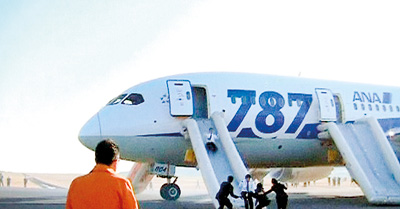Sunday Times 2
Burned out lithium battery that grounded Boeing’s Dreamliner jets
View(s):By Ray Massey and Sara Malm
This burned out battery is what has caused a worldwide grounding of Boeing’s ‘revolutionary’ 787 Dreamliner jets.
Photographs of the charred remains of lithium ion batteries from two separate incidents resulting in the grounding of Japanese Boeing Dreamliners indicate it operated at a voltage above its design limit.
Today U.S. officials joined Japan’s probe into the jets after all 50 of the 787s in use around the world have been stopped from flying.

Grounded: Passengers are forced to evacuate a Japanese Boeing Dreamliner using the plane's escape slides following an emergency landing
The new generation of light lithium batteries was going to deliver equal power at half the weight, but it appears that the chemistry inside the ‘thermal runway’ can self-heat if external temperature and pressure change, something which frequently occurs in aviation.
Concerns over the battery, prompted by an emergency landing of an All Nippon Airways plane on Wednesday, has seen the plane grounded across the globe.
The American investigators – one each from the Federal Aviation Administration and the National Transportation Safety Board and two from Boeing Co. – today inspected the ANA jet on the tarmac at Takamatsu airport in western Japan.
An initial inspection by Japanese officials of the 787 found that a flammable battery fluid known as electrolyte had leaked from the plane’s main lithium-ion battery beneath the cockpit. It also found burn marks around the battery.
Eight airlines fly the ‘plastic plane’, so-called because its fuselage is ‘spun’ from super-strong but lightweight carbon fibre, which cuts weight and fuel consumption, rather than constructed from aluminium.
British Airways has ordered 24 and holiday firm Thomson Airways has ordered 8 of the planes – with their deliveries starting from next month – but say they are standing by the stricken airliner. Thomson is scheduled to be the first British flyer of Dreamliners in May.
GS Yuasa Corp., the maker of the lithium-ion batteries used in the 787s, said Thursday it was helping with the investigation but that the cause of the problem was unclear.
It said the problem could be the battery, the power source or the electronics system. European air safety bosses acted just hours after America’s Federal Aviation Authority (FAA) issued an ‘Emergency Airworthiness Directive’ to halt flights of the planes – the first time a fleet of aircraft has been grounded across the world in 34 years.
The FAA’s emergency directive said the action was ‘prompted by recent incidents involving lithium ion battery failures that resulted in the release of flammable electrolytes, heat damage and smoke’ on two aircraft.’ It said: ‘The cause of these failures is currently under investigation’ but warned more ominously:
‘These conditions, if not corrected, could result in damage to critical systems and structures , and the potential for fire in the electrical compartment.’
The decision to ground the 50 planes currently in service is a humiliating blow to the world’s biggest aircraft maker, which has seen its shares plummet since the emergency ANA jet emergency landing on Wednesday.
Some 137 passengers and crew members on an All Nippon Airlines flight were evacuated down escape chutes when smoke was detected on board.
The Dreamliner is the first airliner to make extensive use of lithium-ion batteries. They charge faster and can be better moulded to space-saving shapes compared with other aeroplane batteries.
But the electrolyte fluid also conducts electricity, so as it spreads it can cause short-circuits and ignite fires.
Jim McNerney, Boeing’s chairman, president and CEO, said the company is working with the FAA to resolve the situation as quickly as possible.
‘We are confident the 787 is safe and we stand behind its overall integrity,’ he said in a statement. ’We will be taking every necessary step in the coming days to assure our customers and the traveling public of the 787′s safety and to return the airplanes to service.’
Mike Sinnett, chief engineer on the 787, said last week that the plane’s batteries have operated through a combined 1.3 million hours and never had an internal fault.
He said they were built with multiple protections to ensure that failures ‘don’t put the airplane at risk’.
© Daily Mail, London
Follow @timesonlinelk
comments powered by Disqus















